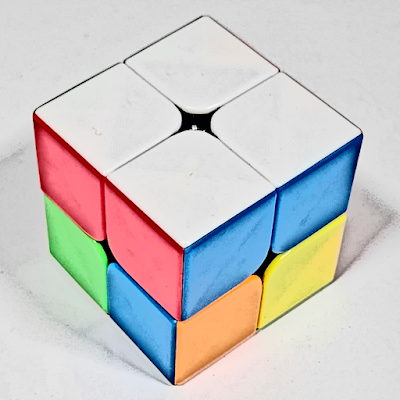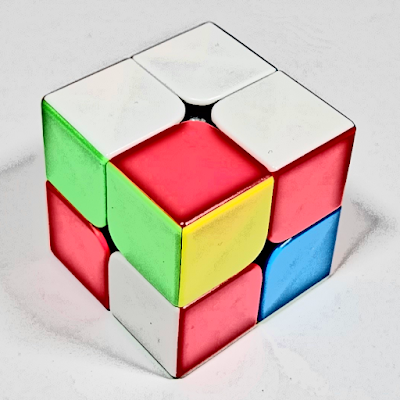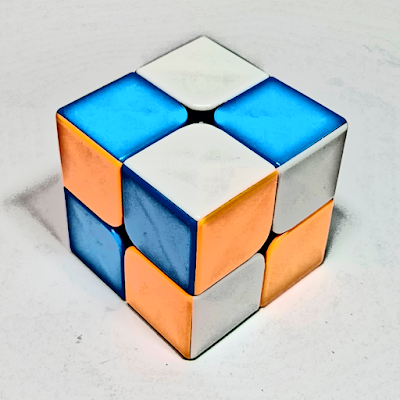The Pocket Cube
Rubik's cubes have a strange place in our pop culture as artifacts that only geniuses can solve, but the many guides on solving them have made solution techniques pretty accessible to a wide audience. Mathematicians like them because they provide a shiny introduction to group theory that leave students with a neat party trick. Today we'll look at the "pocket cube" (the 2x2x2 version, typically abbreviated 2x2), which I've had good luck introducing to beginners.
Setup
To do this activity, you'll need a pocket cube. There are a lot of options out there. I try to avoid models with stickers, so here are a few that fit that bill:
A namebrand option: Original 2x2 Rubik's Cube for $8
A fancy option: GAN 2x2 Magnetic Speed Cube for $26
A bulk option: QiYi 2x2x2 cube for $1.03
Combo packs:
2x2 and 3x3 for $8
2x2, 3x3, and pyramid for $12
2x2, 3x3, 4x4, and 5x5 for $21
In order to explore properties of the cube, it's best to first know how to solve it as a means of "resetting" it, since it is far easier to identify when the cube is in a solved state than any particular unsolved state. We'll approach solving this in three steps:
Solve the top face and edges
Solve the bottom face
Solve the bottom edges
This is not the most efficient method but definitely one of the conceptually easiest methods of solving the puzzle.
1. Solve the top face and edges
This is usually a good step to let students wrestle with on their own. Have them focus on a single color and try to make an entire face that color. It's easiest if they try for the same color every time, since knowing what color will be on the opposite face once it's solved will be important. We'll adopt the popular standard of solving white and remembering that yellow will be its opposite face. (The other pairings on a standard cube are red opposite orange and blue opposite green, but if you end up with a cube that doesn't fit these conventions, find a pairing choice that works for you.)
The eventual goal is to have the white face's layer solved so that its edges all match. Here is an example of a solved top layer from two angles:
Students likely won't have too much trouble finding a way to put two white squares next to each other so their edges match. For example, the two white squares on pieces that have blue squares.
By playing with only the two axes that leave those two white squares together, it's also not too much trouble to get a third white square in place so that one of its edges matches the edge of on of the white squares in the original pair.
Getting the last white square in place is the tricky part, because it can't be done without moving some of the three solved white squares. To do this, find the last white square. If it's in the bottom layer, move it so that it is below the place you want it to end up. The maneuver is then to rotate two white squares out of the way, rotate the piece up from the bottom layer, and then rotate the two white squares back into place.
If it was in the top layer or ended up there but rotated incorrectly, move the two white squares out of the way, rotate the last white square piece to where one of them had been, and then rotate the two white squares back into place, knocking the incorrectly rotated white piece back into the bottom layer.
Now that it's in the bottom layer, we can try the bottom layer maneuver again.
While there are more systematic ways to go about solving the top layer and edge, this is the step of solving the cube that students are most likely to invent themselves via their geometric intuition, so give them space to do it!
2. Solve the bottom face
For this step and the next one, we'll adopt the following convention. If you hold the cube so that one face faces you and another face points up, then the faces will be called L (left), R (right), U (up), D (down), F (front), and B (back). Here, F is the face facing you, B is the face pointing away from you, U the top face, D the bottom face, L the face on your left, and R the face to your right.
Our convention will now be that the move \(X\) is rotation of face X by \(90^\circ\) clockwise while \(X'\) is rotation of face X by \(90^\circ\) counterclockwise.
Once the top layer and edges have been solved, if the cube is flipped so that the white face is face D, then face U will have 0, 1, 2, or 4 yellow squares. The sequence of moves we will apply will always be the same, but the way we hold the cube and the number of times we apply it will depend on which case we're in. The sequence of moves is:
\[ R \, U \, R' \, U \, R \, U \, U \, R' \, U \, U \]Always hold the cube so D is white. If U has all 4 squares yellow, this step is complete, so no moves are required.
For the other cases, bounce between these instructions until U is yellow:
If U has 0 yellow squares, apply the above sequence of moves 1 time so the number of U yellow squares is nonzero.
If U has 1 yellow square, hold the cube so this yellow square is in the FUL corner and apply the above sequence of moves 1-2 times until all U squares are yellow.
If U has 2 yellow squares, hold the cube so those yellow squares are the UR edge or the BUL and FUR corners and apply the above sequence of moves 1-2 times until only 1 U square is yellow.
3. Solve the bottom edges
You should now have the white layer solved with all of its edges matching and the yellow layer solved with some edges possibly mismatched.
If some of the yellow layer's edges match, then setting white D and yellow U, applying \(U\) 1-3 times should result in at least one face other than white or yellow being all one color.
If this results in a solved cube, you're done! Otherwise, orient the cube so that white is F, yellow is B, and the third solved face is D.
Then apply the sequence
\[ R' \, U \, R' \, D \, D \, R \, U' \, R' \, D \, D \, R \, R \, B' \]This should solve the cube.
Sometimes none of the edges in the yellow layer match.
In this case, orient the cube any way you like so that white is F and yellow is B. Applying the above move sequence should leave you in a place where you can solve a third face as in the previous step and then solve the cube.
Initial Questions
What is it that the sequences
\[ R \, U \, R' \, U \, R \, U \, U \, R' \, U \, U \]and
\[ R' \, U \, R' \, D \, D \, R \, U' \, R' \, D \, D \, R \, R \, B' \]do in the algorithm? Is there a way to describe them conceptually?
Can you find any other sequences that are useful for solving the cube?
Explorations
-
If we try our move sequences starting from the solved state, it's much easier to see what they do.
-
If we apply
\[ R \, U \, R' \, U \, R \, U \, U \, R' \, U \, U \]three times starting from the solved state, we get back a solved cube.
In between, we see the net effect of each application is rotating the three corners BUL, BUR, and FUR by \(120^\circ\) clockwise and leaving everything else alone. Three applications of this effectively rotates each \(360^\circ\), resulting in no net effect.
Understanding this clockwise rotation can be useful for finding quicker ways to solve the cube. For example, if we see that a \(240^\circ\) rotation would be necessary based on eyeballing corners BUL, BUR, and FUR, we could instead hold the cube so that yellow layer corner we wish to fix is FUR and then applying the mirror of \(R \, U \, R' \, U \, R \, U \, U \, R' \, U \, U\), which is \(L' \, U' \, L \, U' \, L' \, U' \, U' \, L \, U' \, U'\).
-
Applying
\[ R' \, U \, R' \, D \, D \, R \, U' \, R' \, D \, D \, R \, R \, B' \]twice to a solved cube returns a solved cube.
We can see that each application interchanges corners BUL and BUR in a way that BUL becomes BRU and BUR becomes BLU.
-
Despite being rather complicated moves, we've seen that the sequences
\[ R \, U \, R' \, U \, R \, U \, U \, R' \, U \, U \]and
\[ R' \, U \, R' \, D \, D \, R \, U' \, R' \, D \, D \, R \, R \, B' \]have orders 3 and 2, respectively, where the order of a move sequence is the number of times it needs to be applied before you get back to the state you started with. What other sequences have order 2 and 3?
Since applying \(R\) 4 times returns us to the starting state, \(R\) has order 4 and \(R \, R\) has order 2.
The sequence \(R \, R \, U \, U\) has order 3. (It turns out that at least four \(90^\circ\) turns are required to make a sequence with order 3.)
In the language of group theory, the move sequences we are exploring are elements of the 2x2x2 Rubik's cube group. The order of a group element is the number of times it can be composed with itself (multiplied, added, or whatever the group operation is called) before we get the identity element, which in this case is "no net change." Students might like exploring the question of what other element orders they can find.
By Lagrange's theorem, the order of an element must divide the total number of elements in the group, called the order of the group. In this case, the order of the group is
\[ 3674160 = 2^4 \cdot 3^8 \cdot 5 \cdot 7 \]so 11 and 13, for example, cannot be the orders of elements. Here are examples of elements with orders 2-10:
Order Element \(2\) \(R \, R\) \(3\) \(R \, R \, U \, U\) \(4\) \(R\) \(5\) \(R \, U \, R' \, U\) \(6\) \(R \, U \, R' \, U'\) \(7\) \(R \, U \, L \, U'\) \(8\) \(R \, R \, L \, L \, U\) \(9\) \(R \, U'\) \(10\) \(R \, U \, F\) Are there any nice geometric descriptions of what these elements do to the cube that explain why their orders are what they are?
-
Once students are able to reliably solve the cube, they might wonder if there are any other interesting states to aim for. Here are some possible challenges:
-
Is it possible to arrange the cube so that all four colors on each face are different?
If so, what is a move sequence that gets there from the solved state? If not, what's the largest number of faces that can simultaneously have four distinct colors?
-
Is it possible to arrange the cube so each of the six faces is a two-color checkerboard?
If so, what is a move sequence that gets there from the solved state? If not, what's the largest number of faces that can simultaneously be two-color checkerboards?
-
Is it possible to arrange the cube so each of the six faces is a two-color stripe pattern?
If so, what is a move sequence that gets there from the solved state? If not, what's the largest number of faces that can simultaneously be two-color checkerboards? Can it be done so that stripes on adjacent faces are perpendicular to one another?
-
Is it possible to solve the entire cube, except for a single corner?
Students can also look for their own interesting patterns and share them with each other!
-
Wrap-Up Questions
Can you confidently solve the cube? Did you find any helpful tricks for solving it differently?
What interesting color patterns were you able to find? Were any of the solution algorithms useful for helping you find new color patterns?
Extensions
The natural extensions are similar permutation puzzles:
Students would likely enjoy tackling the 3x3x3 cube, since it's the original brainteaser. A nice beginner's algorithm can be found at Ruwix, a great resource for Rubik's cube miscellania, but students might first like to see which of their insights on solving the 2x2x2 carry over. What do the 2x2x2 algorithms do to the 3x3x3?
An extension that is less complicated, overall, despite its initial appearance is the Pyramorphix. Though it looks different, this puzzle actually has the same movements as the pocket cube. Studying it and seeing why knowing how to solve the pocket cube gives a solution to this puzzle is a great exercise in geometric thinking.







































Comments
Post a Comment